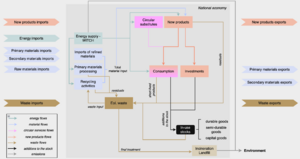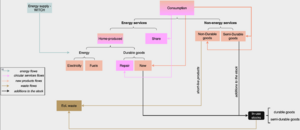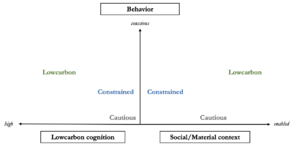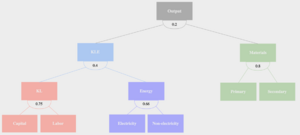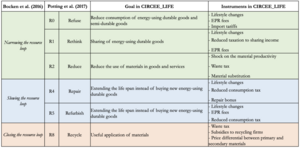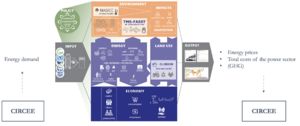CIRCEE
General Scope and Connection with Climate Mitigation
Introduction
Assessing the full potential of a circular economy requires a macro-level and integrated assessment approach that addresses the complex interdependencies and trade-offs between environmental, social, and economic objectives. Policy support, lifestyle changes, innovation, and new business models such as sharing and digitalization models are critical enablers for the transition to a circular economy, as well as a deep understanding of the underlying drivers and barriers. Also, it is important to understand the hypothetical synergies, benefits and trade-offs with implementing different circular economy strategies As these policies and lifestyle changes are vital in driving the transition toward a circular economy, understanding their implications is essential. Assessing the impact of a CE on socioeconomic systems remains a complex and challenging task for Integrated Assessment Models and the macroeconomic modeling community. Pauliuk et al. (2017) emphasize the necessity of incorporating industrial ecology system linkages into Integrated Assessment Models.
CIRCEE (CIRCular Energy Economy), developed by the RFF-CMCC European Institute on Economics and the Environment, addresses these challenges by developing a stylized DSGE model, soft-linked to the WITCH integrated assessment model and the LIFE model of Pettifor, Wilson, and Agnew (2023)[1], that integrates some industrial ecology aspects and lifestyle heterogeneity. Our framework captures the dynamic feedback loops between physical and economic systems and assesses the trade-offs and synergies between different sustainability objectives. The stylized model will serve as a starting point for the IAM community and help map CE strategies into existing climate scenarios.
Model Scope
CIRCEE is a deterministic Dynamic and Stochastic General Equilibrium (DSGE) model with resource stock/flow consistency. It incorporates some industrial ecology principles to evaluate how CE strategies and enablers can decrease future greenhouse gas emissions and enhance resource efficiency. First, the production-side of the economy follows a standard Constant Elasticity Substitution (CES) tree (see Figure) that combines different CES nests of inputs capital, labor, energy and materials. For accounting reasons, the CES nest of material inputs that combines primary materials and secondary materials is transformed as an additive function of the two inputs à la Mensbrugghe and Peters (2016). The material additive CES function allows us to verify the mass balance condition, and track material flows in a more precise manner. Each sector of final good production obey the rule of conservation of mass. The production structure of the economy is not changed, as it still produces from a standard nested CES function of capital, labor, energy and materials. Materials entering the system must equal to material leaving the system, whether it be in the form of good exports, additions to the in-use stocks or waste disposal. Second, we ensure that a 100% recycling scenario is not feasible, so that the economy cannot recover all recyclable waste. A ‘loss’ parameter, estimated from data about recycling activities, is attached to the use of recyclable waste in the production process of secondary materials to capture the environmental loss of materials during the recycling process. In addition, there is a natural obsolescence rate of durable goods, so that durable goods cannot be repaired on and off. Raw materials are extracted from abroad and are then used for material processing that feeds the production processes of final goods in terms of primary material inputs. These final goods are then consumed and disposed of at a certain time depending on the life of the goods. The waste generated by end-uses as well as production processes can be either landfilled/incinerated or recycled. Recycled/recovered materials can be fed back to the economy to ensure a higher circularity rate or exported abroad. I
**
The economy is populated by heterogeneous households, producing sectors and a public authority.
On the demand side of the economy, three types of households are differentiated by their lifestyles and liquidity constraints. Households choose to consume different types of goods: non-durables, semi-durables and durable goods, and services : home-produced energy services, sharing energy services, and repairing services. They make intratemporal choices regarding the composition of their consumption basket (e.g. consuming sharing energy service rather than producing it at home) and intertemporal choices between different types of assets available to them (capital, durable and semi-durable goods). In CIRCEE, owners can make their durable goods available for rent to other individuals when they are not using them and are willing to rent them. The lifestyles are those outlined in the Pettifor, Wilson, and Agnew (2023)[1]. Low-carbon behaviors (lifestyles) are driven by cognitions and social/material contexts. They affect directly households' preferences in :
- repairing durable goods rather than buying brand new
- sharing a durable goods rather than buying brand new
- lowering expenditures in durable goods and semi-durable goods (sufficiency)
On the economy's supply side, the economy is populated by eight sectors producing the following products: primary materials, secondary materials, non-durable goods, semi-durable goods, durable goods, capital goods, sharing energy services and repairing services. All goods and services sectors, except the repairing and sharing sector, produce from labour, capital, energy (electricity and fuels), and material (primary and secondary) inputs. The repairing sector only produces repairing/refurbishing services using labor and capital. The sharing sector rents part of the durable good stock owned by households, uses energy and labor to produce sharing services. Material processing firms use labor, capital, energy and raw or waste material inputs to produce primary and secondary materials. The production structure of the economy is economically and physically consistent, in the sense that it verifies the mass balance of the system. The energy supply side is exogenous of CIRCEE. CIRCEE is soft-linked to the IAM model https://www.witchmodel.org/ from the RFF-CMCC European Institute on Economics and the Environment (EIEE) to assess the overall GHG mitigation potential of circular economy strategies.
The government levies taxes, implements circular economy policies, and makes public expenses. In addition, the model considers trade flows between the domestic economy and the rest of the world.
The current geographical scope of CIRCEE is Japan, France and EU27. Data availability will determine which more OECD countries can be added to the model. However, users may add other countries themselves, provided there is enough data to calibrate the model.
CIRCEE users can run the model for any desired number of years, using 2018 as the base year value. A longer time horizon can also be run to avoid any end-of-horizon effect, but 2080 is generally sufficient. Results are usually reported for the period 2019-2060. The model has a yearly time step. CIRCEE allows the users to choose between all SSPs but SSP3.
Model Development
- Status: in progress.
- Environment: The model uses the open-source modelling platform dynare which requires matlab, GNU Octave or julia.
- Documentation: in progress. Not yet available.
- Source code: link available end of May 2024 (M24 in CIRCOMOD).
Circular Economy Features
R Words coverage and implemented in the model
CIRCEE offers a comprehensive outlook on the socio-economic-climatic consequences of implementing circular economy practices by integrating different strategies. At the macro level, CIRCEE encompasses the following R strategies. The first one is Recycle R8, which involves using secondary (recycled) materials instead of primary (virgin) materials. Increasing material circularity through strategies is key to the vision of a circular economy. The second one relates to Reuse R3, Repair R4 and Refurbish R5, which involves substituting newly produced goods with repaired or second-hand items to extend the lifespans of products, replacing new goods with services (such as in the sharing economy), and intensifying the use of long-lived goods (also in the sharing economy). The third encompasses Rethink R1, Reduce R2 and Refuse R0 which involves enhancing material productivity through technological advancements,, adopting Green Product Design to increase the durability and recyclability of goods, sharing products, and sufficiency behaviors. These strategies emphasize the significance of lowering material flows within the economy. Green product design is crucial in slowing down material flow by creating more durable and repairable goods. To support the economy's transition toward circularity, CIRCEE integrates various exogenous policies and economic instruments.
CE strategies and connection with climate change mitigation.
CIRCEE can activate various exogenous instruments, depending on different narratives, to help the economy to circularity. Each instrument has a direct (★) or indirect (☆) impact on GHG emissions.
| Legend |
|---|
| ★: direct impact on GHG mitigation ☆: indirect impact on GHG mitigation |
1. Substitute secondary (recycled) materials for primary (virgin) materials (Recycle (R8))
- Waste tax ★
- Subsidies to recycling activities ☆
- The shock on the recyclability rate of waste ★
- Shock on the price differential between primary and secondary materials ★
- Shock on material prices ☆
2. Substitute repaired and second-hand for newly produced goods (Re-use (R3), Repair (R4), Refurbish (R5))
- Discount/no VAT for repairing services ☆
- Repair bonus ☆
- Shock on second-hand goods demand ★
- Reduced transaction costs on second-hand markets ☆
- Lifestyle changes ★
- EPR fees to incentivize sustainable consumption decisions ★
3. Replace new goods with services (sharing economy) (Rethink (R1))
- Lifestyle changes ★
4. Increase the utilization rate of long-lived goods (sharing economy) (Rethink (R1))
- Shock on the utilization rate of durable goods ★
6. Reduce the use of materials in production processes (Reduce (R2))
- Waste tax ★
- Shock on the material loss during the production process of goods ★
- Shock on material productivity ★
7. Substitute non-material inputs for materials (Refuse (R0))
- Shock the substitution elasticity between non-resource resource inputs and resource inputs for key sectors ★
8. Green Product Design to increase longevity of goods (Rethink (R1))
- Decrease the depreciation rate of durable, semi-durable and capital goods ★
- EPR fees to incentivize green product design
9. Reduce the consumption of certain goods (Reduce (R2))
- Lifestyle changes ★
- EPR fees to incentivize sustainable consumption decisions ★
Synergies and trade-off between the R-word in the context of the stylized model
On the demand side, in response to exogenous incentives, households make inter-temporal trade-offs between different kinds of assets, such as newly-produced capital and durable goods and second-hand durable goods. Besides, households also make intra-temporal trade-offs between different kinds of goods and services. For instance, when a durable good such as a car reaches the end of its useful life, households have three options to continue consuming the energy service "mobility":
- Purchase a newly produced car, which requires new materials and energy inputs. However, the new car typically has higher energy efficiency than the old one.
- Continue consuming the energy service without purchasing a new car by engaging with the repairing service sector to extend the life of the old car. However, this option may have a negative impact on the overall energy efficiency of cars.
- Participate in the peer-to-peer sharing market to use a car, without directly owning it, jointly with energy.
- Participate in the second-hand car market, where they can purchase a used car that is not yet at the end of its useful service life.
On the supply side, sectors make intra-temporal trade-offs between different input mixes. For instance, firms may increase the use of recycled materials in their production process in response to external incentives promoting more circular behaviour.
Refinement, Integration, Future Development
Refinement process
The current version of CIRCEE does not account for endogenous green product design. Even though, behavioural plasticities can enable many different circular economy strategies, they also rely on the availability of design technology aiming at extending the lifespan of the products. Future versions should consider incorporating these aspects, especially considering that an increased EPR fee might lead producers to innovate in product design, favoring more sustainable and cost-effective production methods. This would necessitate a disaggregated representation of products in CIRCEE, focusing on key designs (repairability and durability) that dictate green product design, and could involve linking detailed, product-focused models with CIRCEE for a broader understanding of potential synergies and trade-offs between demand- and supply-side circular economy strategies.
In addition, incorporating endogenous technological advancements toward increasing material productivity and recycling quality into the CIRCEE model depends on the accessibility of comprehensive and detailed data. This endogenous representation of technical change for material productivity and recycling quality in macroeconomic and integrated assessment models is, to our knowledge, nonexistent. To effectively integrate these advancements, the model requires open data on patents and R&D investments directed toward enhancing material productivity and the quality of recycled materials. Data on patents, and on their impact of material input mid in manufacturing processes, can reveal the direction of innovation and provide insight into future market trends regarding material efficiency and recycling technologies. Similarly, R \& D investment data can indicate the commitment and potential of industries to adopt such technologies. However, this also demands in-depth industrial surveys to assess the availability, cost, and efficacy of existing and emergent recycling technologies.
Furthermore, a better understanding of the dynamics between primary and secondary markets is vital. This includes understanding pricing mechanisms, demand and supply fluctuations, and substitution elasticity between primary (virgin) and secondary (recycled) materials. Clarity in how these markets interact and operate will provide a starting point for assessing how technological changes can affect market balances and recycling behaviors.
The advancement of CIRCEE depends on open access to comprehensive datasets and sufficient funding to study the multifaceted aspects of a circular economy, from the micro-level specifics of green product design to the macro-level implications for resource efficiency and economic growth. Securing dedicated funding is critical to support the extensive data collection and surveys necessary to develop these model components. As CIRCEE is an open-source model, it can greatly benefit from the support of a research community, which allow for such collaborative development through shared knowledge and resources. Such a model would provide policymakers with valuable insights, enabling them to make well-informed decisions that balance the various synergies and trade-offs of circular economy strategies.
Integration
CIRCEE can be easily similarly linked with other IAMs to WITCH. In particular, the primary output of CIRCEE that is utilized as an input in IAMs is the energy demand. From the energy demand, IAMs simulate the trajectory of energy prices of the energy system and future GHG emissions that are fed into CIRCEE. From the new energy prices, CIRCEE feds back to the IAM the new energy demand. The user would repeat this cycle until the two models converge, implying that the energy demand, energy prices, and GHG emissions stabilize. Note that if the material requirement of power generation technologies are present in the IAM, it can be linked to the material/waste stock and flows of CIRCEE.
Future features of the model.
- CIRCEE's current version includes exogenously technological change that is directed towards improving material productivity and recycling quality. A future version will include an endogenous representation of this technological change;
- CIRCEE's stable version does not include second-hand markets, though an unstable version exists. The future stable version will enable the exchange of durable goods in second-hand markets;
- A future version of CIRCEE will include endogenous green product design under the presence of circular services markets (repairing and sharing markets).
References
- ↑ 1.0 1.1 Hazel Pettifor, Maureen Agnew, Charlie Wilson. A framework for measuring and modelling low-carbon lifestyles, Global Environmental Change, Volume 82, 2023, 102739, ISSN 0959-3780, https://doi.org/10.1016/j.gloenvcha.2023.102739.

